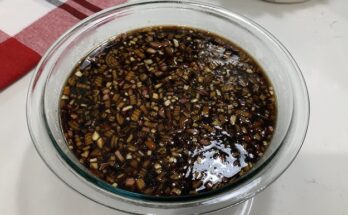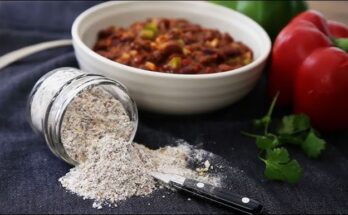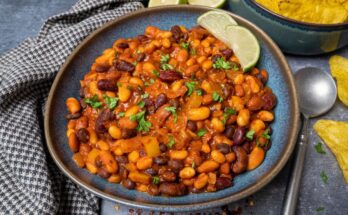Fried Chicken Breast Recipe: There’s nothing quite like biting into a crispy, juicy, and perfectly seasoned piece of fried chicken breast.
Whether you’re preparing a weekend feast or just satisfying a sudden craving, this step-by-step guide will help you master the art of frying chicken breasts that are both crispy on the outside and tender inside.
Why Fried Chicken Breast is a Favorite
Fried chicken breast has earned a spot in the heart of comfort food lovers across the world. Unlike chicken thighs or drumsticks, chicken breasts are leaner, making them a healthier option for those looking to cut back on fat while still indulging in a fried delicacy. The texture is perfect for absorbing flavors, and when done right, the breast stays moist and flavorful under that irresistible golden crust.
This dish is versatile. You can pair it with mashed potatoes, coleslaw, or stuff it in a sandwich for a hearty meal. It’s also a favorite in both Southern cuisine and international variations, like Japanese karaage or Korean fried chicken. The trick lies in the seasoning and technique—and we’re about to dive deep into both.
Healthier Choices with Chicken Breast
Chicken breast is naturally lower in fat compared to other cuts. For those watching their cholesterol or aiming for a protein-rich meal, this makes it a go-to choice. The challenge, however, is keeping it from drying out during the cooking process. That’s why proper preparation, marinating, and frying technique are crucial. With a few smart choices, you can create a fried chicken recipe that’s indulgent yet not too heavy.
Ingredients You’ll Need
Core Ingredients
Let’s talk essentials. To make the perfect fried chicken breast, you’ll need the following:
- Chicken Breasts – Boneless and skinless, ideally even-sized for uniform cooking.
- Buttermilk – The acid helps tenderize the chicken and adds a tangy flavor.
- Flour – For coating; all-purpose flour works best.
- Eggs – To bind the coating.
- Salt & Pepper – Base seasoning.
- Garlic Powder, Onion Powder, Paprika – Adds depth and that signature Southern flavor.
- Oil for Frying – Peanut or vegetable oil are good choices due to their high smoke points.
These basic ingredients are pantry staples, but they form the foundation of any great fried chicken recipe.
Optional Add-ons for Extra Flavor
Want to level up your fried chicken breast? Try these:
- Hot Sauce or Sriracha – Mix it into the marinade for heat.
- Cornstarch – Combines with flour for an extra crispy crust.
- Fresh Herbs (like thyme or rosemary) – Add to the marinade or flour for an herbal note.
- Pickle Juice – Secret ingredient for a Chick-fil-A-style tang.
These extras aren’t necessary, but they can help create a signature dish that suits your taste preferences.
Preparing the Chicken Breast
Cleaning and Trimming
Start by rinsing your chicken breasts under cold water and patting them dry with paper towels. Then, trim off any excess fat or gristle using a sharp knife. This helps ensure even cooking and a better bite.
Once trimmed, consider slicing thicker breasts in half horizontally to create thinner cutlets. This not only helps with portion control but also ensures even frying, preventing the outside from burning before the inside cooks through.
Tenderizing for Juicier Results
Tenderizing isn’t just for beef. For chicken breast, a light pounding with a meat mallet breaks down muscle fibers, allowing the meat to absorb marinades better and cook more evenly. Place each breast between two sheets of plastic wrap and gently pound it to an even thickness—about ½ inch is ideal.
This step might seem small, but it makes a huge difference in texture. You’ll end up with fried chicken that’s not just crispy, but also incredibly juicy inside.
Marinating the Chicken
Classic Buttermilk Marinade
The buttermilk marinade is a game-changer. Not only does it tenderize, but it also adds a rich, tangy flavor that complements the crispy coating.
Here’s a simple marinade:
- 1 cup buttermilk
- 1 teaspoon salt
- 1 teaspoon pepper
- 1 teaspoon paprika
- ½ teaspoon cayenne pepper (optional)
- 1 tablespoon hot sauce (optional)
Place the chicken breasts in a bowl or resealable plastic bag with the marinade. Let them soak for at least 4 hours—or overnight for best results. The acidity in the buttermilk works slowly to break down the proteins, locking in moisture.
Quick Marinade Alternatives
In a hurry? Try these quicker marinades:
- Greek Yogurt and Lemon Juice – Mix equal parts with salt and garlic for a tangy marinade that only needs 1 hour.
- Mustard and Vinegar – Great for a punchy, sharp flavor. Let sit for 30-60 minutes.
While these alternatives won’t give the full depth of a long buttermilk soak, they’re still excellent options when time is short.
Creating the Perfect Breading
Ingredients for Crispy Coating
Your coating can make or break your fried chicken. Here’s a winning mix:
- 2 cups all-purpose flour
- 1 tablespoon cornstarch (for extra crunch)
- 1 teaspoon each of garlic powder, onion powder, paprika
- ½ teaspoon cayenne (if you like it spicy)
- Salt and pepper to taste
For extra crispiness, some people like to double-dip—flour, then egg wash, then back into the flour. This creates an extra-thick crust that crackles with every bite.
Pro Tips for a Golden Crust
- Use Dry Hands for Coating – Wet hands lead to clumping and uneven breading.
- Shake Off Excess Flour – Prevents the crust from getting gummy.
- Let It Rest Before Frying – Place coated chicken on a wire rack for 10–15 minutes. This helps the coating set.
You want that gorgeous, Instagram-worthy golden brown finish? This is how you get it.
Frying the Chicken Breast
Choosing the Right Oil and Temperature
Getting the oil right is a big deal when frying chicken. You want an oil that can handle high heat without burning. Peanut oil, canola oil, or vegetable oil are all great choices because of their high smoke points and neutral flavors.
The ideal frying temperature is around 350°F (175°C). If the oil is too cool, your chicken will soak it up like a sponge and turn out greasy. Too hot, and the outside will burn before the inside is cooked.
Use a deep-fry thermometer to keep track of the temperature. If you don’t have one, drop a small bit of batter in the oil—if it sizzles and rises to the top quickly, you’re good to go.
How to Fry Chicken Breasts to Perfection
Here’s the step-by-step process:
- Heat the Oil: Fill a deep skillet or Dutch oven with about 2 inches of oil. Heat to 350°F.
- Carefully Lower Chicken In: Using tongs, gently place the coated chicken breasts into the hot oil.
- Don’t Crowd the Pan: Fry in batches. Overcrowding drops the oil temperature and ruins crispiness.
- Flip Once: Let each side cook for about 5–7 minutes or until golden brown and cooked through (internal temp should be 165°F).
- Drain Properly: Place the fried chicken on a wire rack (not paper towels) to maintain crispiness.
You’ll know it’s done when the juices run clear and the crust is a rich, golden brown. It should sound crunchy when you tap it with a fork—pure music for food lovers!
Resting and Serving the Chicken
Why Resting Is Crucial
After frying, don’t dig in just yet. Resting your chicken allows the juices to redistribute, which means a juicier bite. Let it rest for at least 5–10 minutes on a wire rack. This step also helps the crust stay crisp, rather than getting soggy from steam trapped under the chicken.
Resist the urge to cover it with foil—it traps steam and softens the crust you worked so hard to perfect.
How to Serve Fried Chicken Breast
You’ve done the hard work—now it’s time to serve and savor. Here are some tasty pairing ideas:
- Classic Combo: Mashed potatoes, gravy, and coleslaw.
- Southern-Style: Serve with biscuits, mac ‘n’ cheese, and greens.
- Modern Take: Slice it up and put it on a waffle with maple syrup.
- Light Meal: Lay it over a fresh garden salad with vinaigrette.
Don’t forget the dipping sauces! Ranch, honey mustard, barbecue, or spicy mayo can elevate the experience even further.
Storage and Reheating Tips
How to Store Fried Chicken Properly
Got leftovers? No problem. Store your fried chicken breast in an airtight container in the fridge. To keep it from turning soggy, place a paper towel underneath to absorb any moisture.
For longer storage, freeze the fried chicken breasts. Wrap them individually in foil or plastic wrap, then place in a freezer bag. They’ll keep well for up to 2 months.
Best Ways to Reheat Without Losing Crunch
Microwaving? Nope. That’ll turn your crispy crust into rubber.
Here’s the best way:
- Oven Method: Preheat oven to 375°F. Place chicken on a wire rack set over a baking sheet.
- Reheat for 15–20 minutes or until heated through and the crust is crisp.
For extra crisp, turn on the broiler for the last 1–2 minutes. This way, your leftovers will taste just as amazing as the fresh batch.
Common Mistakes to Avoid
Overcooking the Chicken
The biggest mistake? Dry chicken. Always check the internal temp—165°F is your magic number. Anything above that, and you’re heading into the dry zone. Using a meat thermometer removes the guesswork and ensures perfect results every time.
Undersalting the Seasoning or Marinade
Chicken breast can be bland if not seasoned well. Salt enhances all the other spices and helps bring out the flavor of the meat. Taste your flour mix (without the raw stuff, of course), and don’t be afraid to add a little extra spice to your marinade or coating.
Different Fried Chicken Breast Variations
Spicy Fried Chicken
Love heat? Add more cayenne or hot sauce to your marinade and coating. You can even make a spicy glaze with honey and chili flakes to drizzle over the finished chicken.
Herb-Crusted Chicken
Mix in dried herbs like thyme, rosemary, or oregano into your flour mix. It gives the crust an earthy, aromatic flavor that’s perfect for more refined tastes.
Gluten-Free Option
Replace all-purpose flour with a gluten-free blend or crushed rice cereal. Cornmeal is another excellent substitute that adds a delightful crunch.
Serving Suggestions and Sides
Perfect Pairings for Fried Chicken Breast
A perfectly fried chicken breast deserves sides that complement its crispy, juicy goodness. Here are some popular (and delicious) choices:
- Mashed Potatoes & Gravy: Creamy mashed potatoes with rich, savory gravy make a classic Southern duo.
- Buttermilk Biscuits: Soft, fluffy, and perfect for sopping up leftover drippings.
- Macaroni and Cheese: Gooey, cheesy, and a favorite comfort food that pairs like a dream.
- Coleslaw: The crisp, tangy crunch of coleslaw adds a refreshing contrast to fried chicken.
- Corn on the Cob: Sweet and juicy, it balances the salt and spice of fried chicken beautifully.
For a healthier plate, you could also serve:
- Steamed Vegetables
- Garden Salad with Vinaigrette
- Roasted Sweet Potatoes
The key is balance—combine the rich, fried texture with something fresh or light to round out your meal.
Making It a Meal: Sandwiches and Wraps
Turning Fried Chicken into a Killer Sandwich
Take your fried chicken breast to the next level by turning it into a sandwich. Here’s what you need:
- A Soft Bun: Brioche or potato rolls work best.
- Toppings: Lettuce, tomato, pickles, and a slice of cheese (cheddar or pepper jack are great choices).
- Sauce: Mayo, spicy aioli, or classic ranch.
Assemble it fresh, and you’ve got a restaurant-worthy fried chicken sandwich right at home.
Chicken Wrap Ideas for On-the-Go Meals
Fried chicken wraps are easy, portable, and perfect for lunch or picnics. Use flour tortillas and add:
- Shredded Lettuce
- Chopped Tomatoes
- Red Onion
- Shredded Cheese
- Ranch or Caesar Dressing
Roll it up, slice in half, and enjoy your fried chicken in a fresh, handheld package.
Nutritional Breakdown of Fried Chicken Breast
Calories and Macronutrients
Fried chicken isn’t exactly a diet food, but when you use chicken breast, you’re already making a leaner choice.
Approximate values per serving (1 medium piece):
- Calories: 350–400
- Protein: 30–35g
- Carbohydrates: 15–25g (depending on breading)
- Fat: 18–22g
This makes it a high-protein meal option, and when paired with healthier sides like salad or veggies, it fits nicely into a balanced diet.
Tips to Make It Healthier
- Use whole wheat flour or almond flour for breading
- Air fry instead of deep fry
- Skip the skin to reduce fat
- Serve with steamed veggies instead of fries
The idea is to enjoy it without guilt—and small tweaks can make a big difference.
Fried Chicken Breast for Special Diets
Keto-Friendly Adjustments
Going low-carb? Swap out the flour for:
- Crushed Pork Rinds
- Almond Flour
- Parmesan Cheese
Pair it with cauliflower mash and you’ve got a satisfying keto dinner that still gives you that beloved crunch.
Dairy-Free and Egg-Free Options
If you’re avoiding dairy or eggs:
- Marinate in mustard, lemon juice, or pickle juice instead of buttermilk
- Use a flaxseed or aquafaba wash instead of eggs
- Use dairy-free breading options
These substitutions still result in juicy, flavorful fried chicken—minus the allergens.
FAQs about Fried Chicken Breast Recipe
1. What’s the best way to keep fried chicken breast juicy?
To keep your chicken breast juicy, soak it in buttermilk or a saltwater brine for a few hours before frying. This helps tenderize the meat and lock in moisture during cooking.
2. Should I use boneless or bone-in chicken breast?
Both work well, but boneless chicken breasts cook faster and are easier to manage. If you prefer deeper flavor, bone-in options can be more flavorful but require longer frying time.
3. What oil is best for frying chicken breast?
Use oils with a high smoke point like canola oil, vegetable oil, or peanut oil. These oils help achieve a golden, crispy crust without burning.
4. How do I know when my chicken breast is fully cooked?
Use a meat thermometer to ensure the internal temperature reaches 165°F (74°C). Alternatively, the juices should run clear when the thickest part is cut.
5. Can I fry chicken breast in an air fryer instead?
Yes! While traditional frying gives a richer taste, air frying is a healthier option. Coat the chicken lightly in oil and cook at 375°F (190°C) for about 15-18 minutes, flipping halfway through.
6. How do I make the coating extra crispy?
For a super crispy texture, double-dip the chicken in seasoned flour or a mix of flour and cornstarch, and let it rest for a few minutes before frying.
7. Can I freeze leftover fried chicken breast?
Absolutely. Let the chicken cool completely, wrap it tightly in foil or plastic wrap, and store in an airtight container. Reheat in an oven or air fryer to keep it crispy.
Conclusion
There you have it—everything you need to know about making the ultimate fried chicken breast, step by step. From selecting the right cut to achieving the perfect crust, it’s all about technique, flavor, and a little bit of love. Whether you’re cooking for a family dinner, prepping sandwiches for the week, or impressing guests with your kitchen skills, this recipe has got you covered.
Once you’ve mastered the basics, the variations are endless. Spice it up, keep it classic, or make it diet-friendly—the choice is yours. So grab your skillet, heat that oil, and get frying. Your taste buds will thank you.



